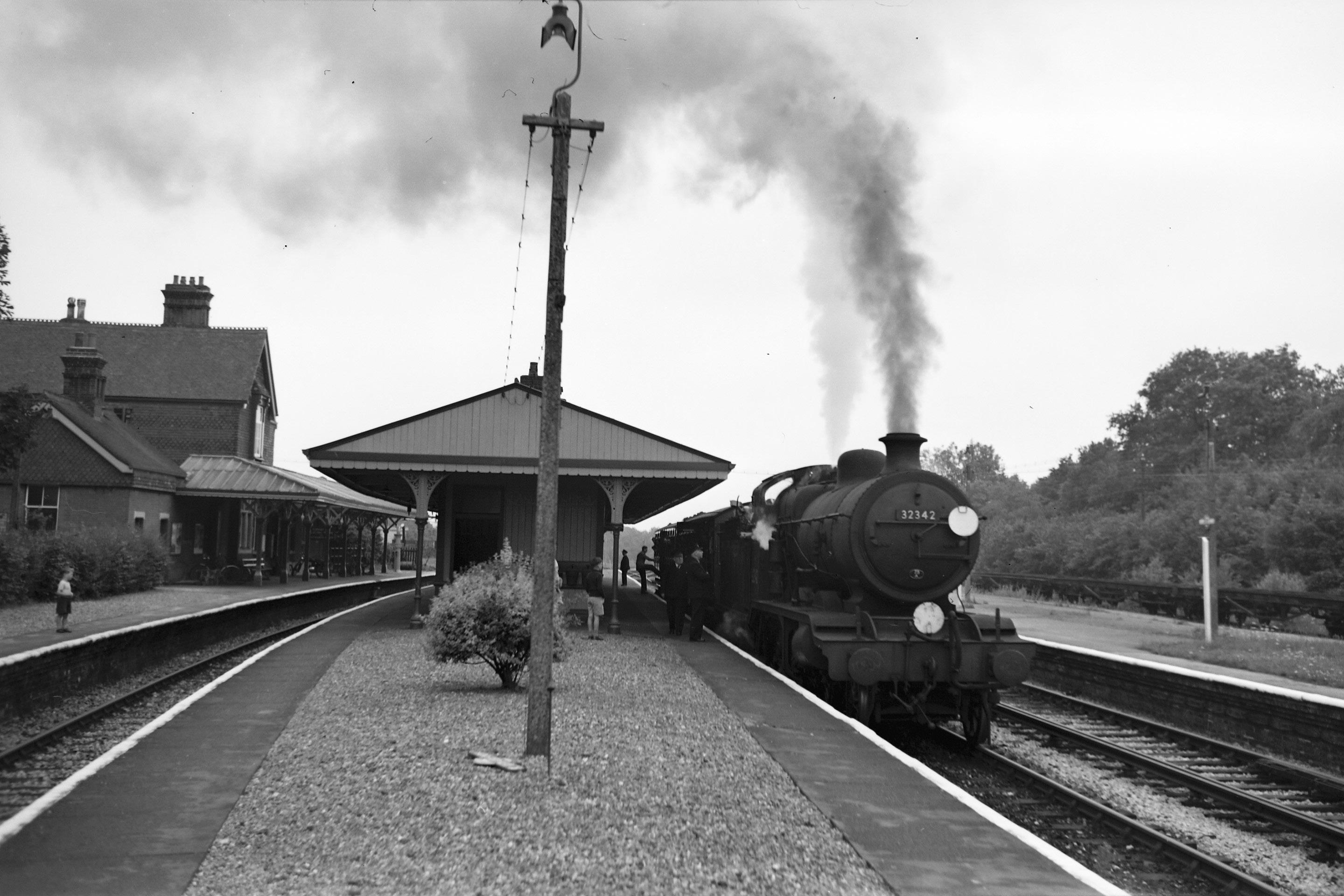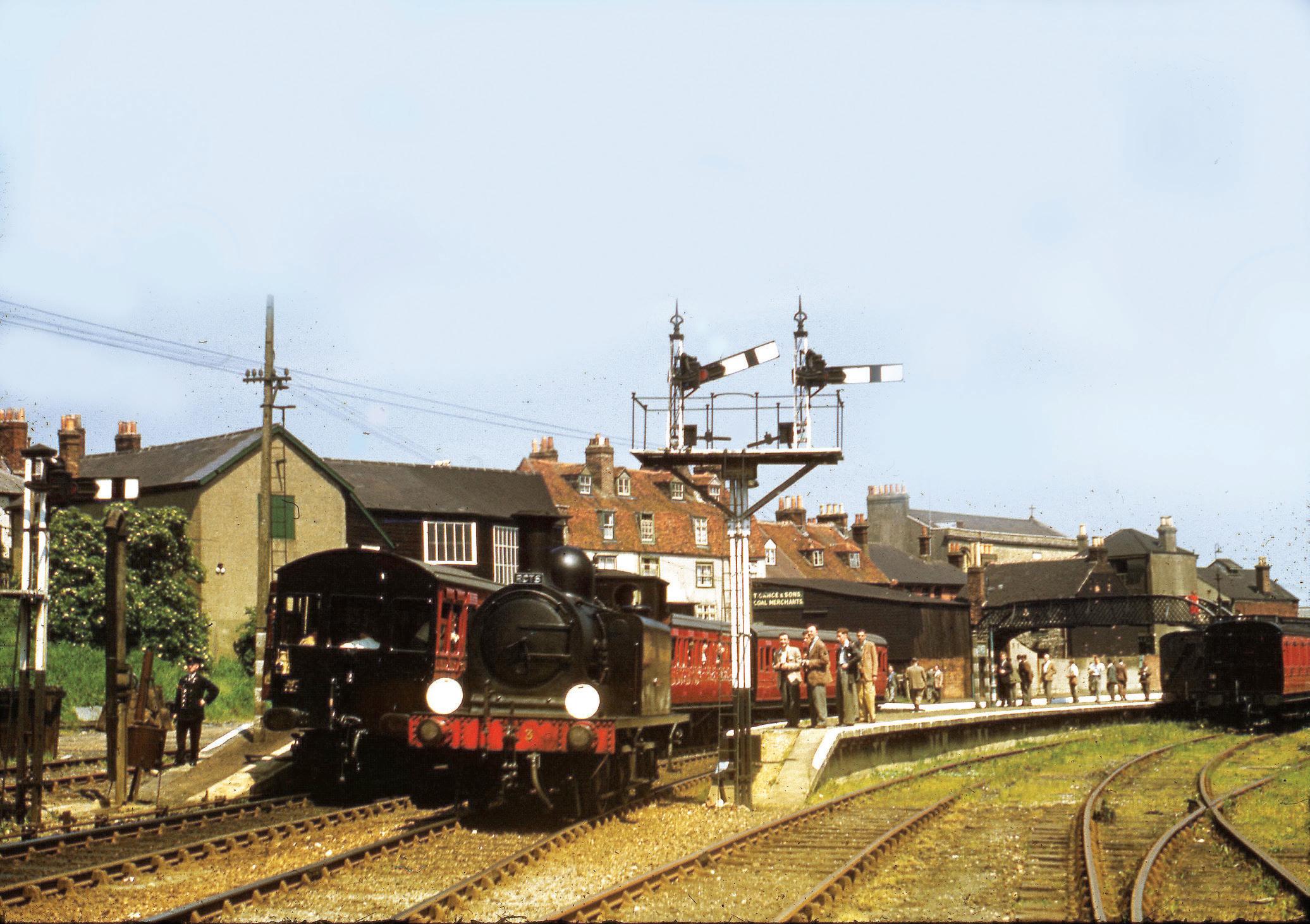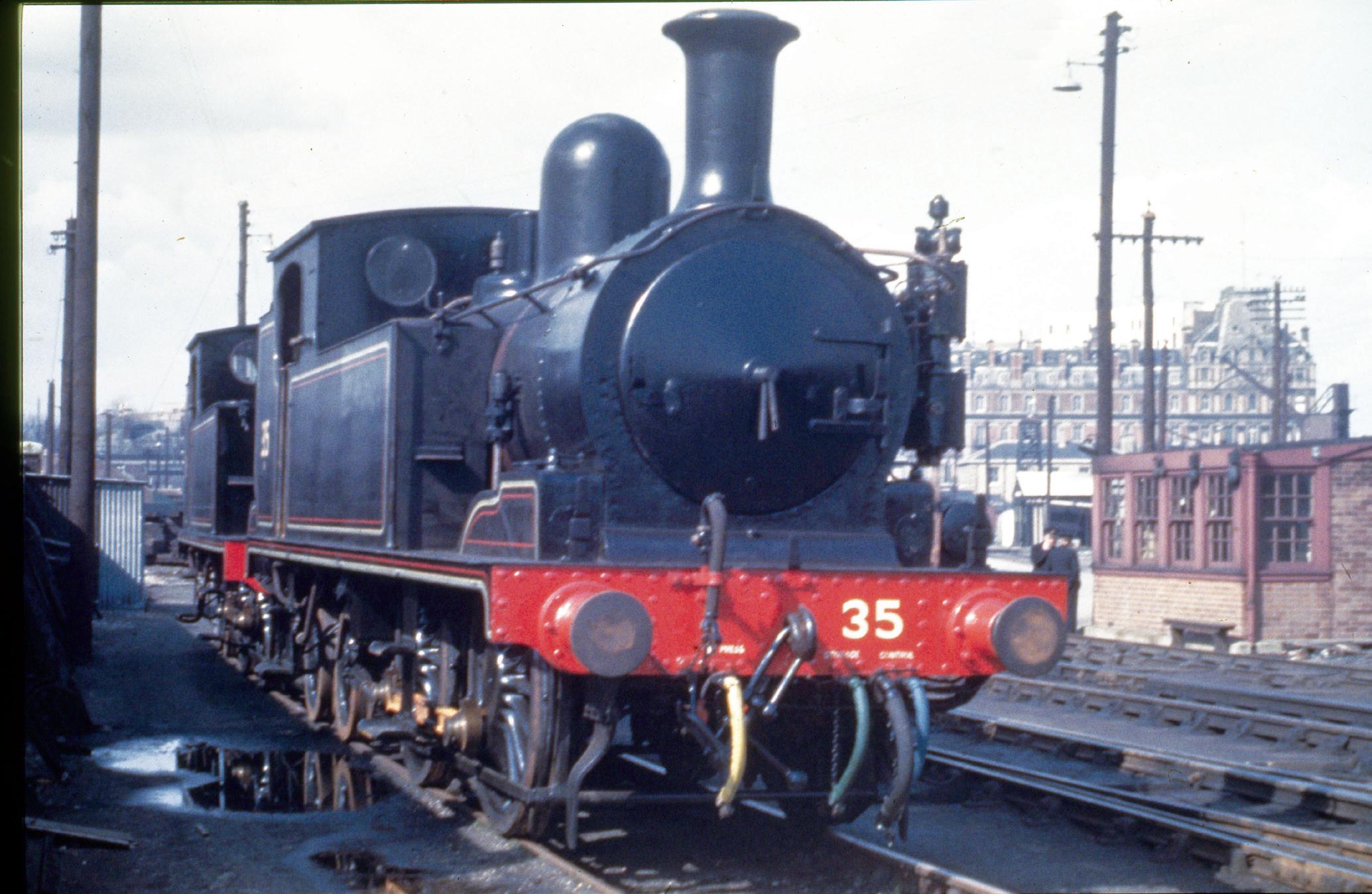SOUTHERN TIMES
We regret but availability of space has precluded the inclusion of all we had promised and similarity intended for this issue including ‘From the Footplate’.
The next issue of Southern Times, No 7, will definitely contain: the N15X rebuilds, Oxted Part , SCT’s images of Bulleid Pacifics, Observations at Farnborough, Treasures from the Bluebell Museum, From the Footplate and whatever else we can shoehorn in! We promise something for everyone.

SOUTHERN TIMES
Contents Introduction 3 The dark days of 80 years ago 5 Newhaven Reflections Howard Cook 14 Southern Region Samples 1960-1972 from the collection of Roger Geech 20 Stained to Wokingham and beyond, Part 2. Jeremy Clark 26 The LBSCR, SR, and BR(S) ‘K’ class 36 Down the line to Oxted; Part 1 Alan Postlethwaite 54 An alternative to preservation –BR’s plans to electrify all or part of the Bluebell Railway – plus some notes on Arthur Earle Edwards 62 Stephen Townroe’s Colour Archive: Visiting the Isle of Wight 69 Answers to the cartoon quiz from page 77, Issue 5 76 Treasures form the Bluebell Railway Museum 77
SOUTHERN TIMES
Not too far north of Harbour station is Newhaven Town which serves the main community. Beyond that remains the once notorious level crossing on the A27 coast road, the scene of many lengthy delays before the bypass flyover was constructed to replace the old iron swing bridge over the river, which ceased operation in 1974. The bridge over the Ouse also carried the West Quay Tramway down to the harbour. This fascinating
Opposite - Marsh/Billinton Class H2
4P No. 2422 North Foreland is seen shunting empty stock on Newhaven East Side having arrived with a Down boat train on 6 August 1939, a month prior to the commencement of hostilities with Germany. Built at Brighton Works in 1911, these 4-4-2s were an instant success on London – Brighton expresses including the elite Pullman services, the ‘Brighton Limited’ and the ‘Southern Belle’. Like the Class H1, the H2s were mainly stored during WWII as a result of the cessation of ferry services but returned to service in peace time and continued operating boat trains until October 1956. The final survivor, as No. 32424, lasted until April 1958 as something of a celebrity locomotive but pleasingly, a replica of Beachy Head is currently being constructed at the Bluebell Railway, utilising many existing components.
Right - Stroudley ‘Terrier’ Class A1X 0-6-0T heading a short transfer goods on 26 August 1961 across the river Ouse swing bridge from the West Quay branch to North Quay. Built in 1875, No. 62 Martello started life on London suburban duties based at New Cross. Shortly before closure of the West Quay branch it was reallocated to Eastleigh to see out the final days of the Hayling Island branch and spared scrapping by becoming an open-air exhibit at Butlin’s Holiday Camp near Ayr before its preservation was secured at Bressingham Steam Museum where it now carries the LB&SCR number B662.
Bottom - 0464 Northampton-based Stanier Class 5MT 4-6-0 No. 45398 is recorded reversing back past Newhaven Town signal box on 19 August 1964 having arrived with the Glasgow – Newhaven ‘Continental’ car sleeper train. Whilst expensive, these summer-only trains were a success until the quality of cars improved and the motorway network was completed. The same journey today takes over 12 hours, entails 4 to 5 changes and costs a little over £141 single but with no car carrier service.

line closed in August 1963 and attracted many photographers whilst in operation. Over the tramway sections, goods trains were preceded by the pedestrian shunter bearing a red flag. One such ‘celebrity’ from the 1930s was Harry Avis who is well-documented in the local history museum, besides giving his name to a trading estate and Avis Road.

17
From the collection of Roger Geech
Setting aside commercial organisations and the national railway societies, one of the most prolific organisations in organising railtours in the 1950s and 1960s was the Railway Enthusiasts Club of Farnborough - and still running as a club today. Their heyday for tours was very much in the years before branch and line closures with regular outings organised both local and national.
One of these type of special were the half-day tours such as took place on 15 October 1960 starting and
finishing at Farnborough taking in the Aldershot Government siding, the Bentley to Bordon branch and the stub ends of both the Basingstoke and Alton and Meon Valley lines from Alton. Originally referred to as the ‘North Hampshireman’ the special was far better known as the ‘Aldershot Area Rail Tour’. Motive power was M7 No 30028 with capacity limited to pull-push set No 1 consisting of two coaches. Departing at 2.05 pm from Farnborough photo stops were made at varying points. The special is seen below traversing the Borden branch.
Opposite - On the racing stretch between Basingstoke and Woking, we have an original light pacific on a Salisbury line working. Stopping services to and from Salisbury continued to be steam hauled up to the time steam was abolished in July 1967. Plans to electrify the section between Basingstoke and Salisbury - and presumably then back from Salisbury to Eastleigh and Southampton - have been on and off the cards several times, in consequence of which Salisbury services are often seen as the poor relation.
We also see a rebuilt pacific powering through Brookwood in the early 1960s at which time in was only the slow lines between Woking and Pirbright Junction which were energised. Brookwood had once been the junction for the Necropolis line into Brookwood cemetery and on the opposite side the short branch to Bisley. Traces of the Necropolis line junction disappeared many years ago but certainly well into the 1960s it was possible to view the steep route and girder bridge which once carried the Bisley branch down and for a short distance parallel to the up side lines.

20 SOUTHERN TIMES
20


47 SOUTHERN TIMES
between East Grinstead and Culver Junction north of Lewes. The following year 1883, Horsted Keynes became a junction with a connection to a 4½ mile line west through Ardingly to Copyhold Junction north of Haywards Heath on the main London to Brighton line. The route from East Grinstead to Horsted Keynes and thence via Ardingly back on to the main line was also an occasional useful diversionary route. The Southern Railway electrified the Ardingly line to Horsted Keynes in 1932 with the new electric service seeing 18 trains a day half of which terminated as a shuttle service at Haywards Heath although the remainder continued on to Seaford.
North and south of Horsted Keynes diminishing traffic receipts on what was without doubt a rural byway serving only limited areas of population, resulted in
Right: Posted from East Grinstead. The small type includes mention that tickets for journeys commencing at Newick & Chailey, Sheffield Park, and West Hoathley will be issues on the train so implying these stations were now unstaffed.
 Gerald Daniels
Gerald Daniels
Bottom: Following the revision of services, this was the first train at Horstead Keynes; the 9.30am from Lewes, due here at 10.04. (We are not told if it ran on time!) ‘K’ No 32342 is in charge of just two coaches and clearly has steam to spare.
 Gerald Daniels
Gerald Daniels
63 SOUTHERN TIMES
On 18 May 1952 SCT was on hand to record W3 in the process of running round at Cowes with the RCTS South of England branch, ‘Isle of Wight Railtour’.

This really was a wonderful opportunity for a day out although it is curious to note there was one section of line not traversed; that from Sandown south through Shanklin and Wroxall to Ventnor (Town). We can find no reason for this so the obvious conclusion must have been simply the time available.
The participants would have congregated at Portsmouth to take the ferry to Ryde where they joined their special train with, we think, W32 Bonchurch at the head. This first part of the tour took the special to Newport where we do know No W3 Ryde took charge for the short run to Cowes. Our photograph is one of two similar views taken by SCT at Cowes, this image showing the engine running round - the second (not included) has the train ready to leave.
No W3 was only used for the return journey to Newport where it was replaced by W32 again for a trip to Freshwater - run round - and return to Newport. Readers will be aware of a further shunt / run round - manoeuvre that would have been needed again in order that W32 might now head on to the Merstone line to end up at Ventnor West where SCT again took a colour view - opposite top.
From Ventnor it was back to the junction at Merstone where No 32 is depicted running around - opposite bottom. It is at this point that matters become slightly confused as the Six Bells Junction webside shows that after returning from Ventnor West the train returned to Newport before retracing its steps again to return over the same route to Sandown. This appears to be contradicted by the image opposite, the only practical reason for such a move being line occupancy, but then why would No 32 be running around its train?
Whatever, at Sandown there was another reversal W32 now heading north to Brading and a diversion on to the Bembridge branch. A further run round at the terminus here , back to Brading - run round - and the third engine of the day, W14 Fishbourne for the final leg back to Ryde Pier Head.
The participants on the day were almost certainly the last railtour travellers to visit Ventnor West which closed just two months later in July 1952. The following year the branch to Bembridge closed along with the line from Newport westwards to Freshwater. The Newport to Sandown line via Merstone similarly succumbed in 1956.
70 SOUTHERN TIMES
SOUTHERN TIMES 70
Comings (without the goings). Top we see W4 Wroxall at Medina Wharf in May 1957. Arriving on the island in June 1933 aged 55, this was the last of the four E1 locos to remain in service here and was withdrawn in October 1960. Bottom are the final two members of the O2s class, Nos W35 and W36, later named Freshwater and Carisbrooke respectively. The view was taken at Southampton Docks in April 1949 with the pair shortly to be transported by barge to the island.


75 SOUTHERN TIMES ISSUE 6
75
Chislehurst, Beckenham Junction, Wimbledon, Leatherhead and Dorking North.
The 16-page notice includes all the empty stock workings to make up the trains and return after depositing their passengers.
While the Southern Railway organised the trains many other organisations were involved in the operation. Maidstone & District Motor Services would be responsible for getting people to the stations, with lists produced to show who was close enough to walk and who needed transport. The local Council had plans to y356

move its offices out of the area. Food stores were set up with 48 hours of food available.
Envelopes were produced to be sent out by ‘special postal delivery’ to each address to inform the public that the evacuation was happening.
The notice for Kent runs to 43 pages and lists 164 trains running over 2 days, again with a capacity of 800 passengers each. For West Sussex there would be 93 electric trains over 4 days, the notice running to 32 pages.


From the Southern Railway Magazine November 1930. Hidden Locomotive Names
‘A correspondent submits the following groups of words, each of which, when the letters are re-arranged, will be found to spell the name of a Southern Railway locomotive.’
(Solutions will be given in the next issue).
79 SOUTHERN TIMES
1. Leeds Main 6. Had Rag Sale
2. Log Went Nil 7. London’s R A
3. Ovens Sent 8. My Golf Arena
4. Let Bark Bore 9. Mark or Sail
5. Sad Vote Here 10. Nor Get Bid
SOUTHERN TIMES is the new periodical for followers of the Southern Railway, British Railways Southern Region, as well as the pre-group companies: SECR, LBSCR, and LSWR
Three issues per year, 80 pages packed with articles and images that are Southern related including where possible, unseen views in every issue.
A subscription service is available through the publisher; The Transport Treasury.

£12.95









 Gerald Daniels
Gerald Daniels
 Gerald Daniels
Gerald Daniels







